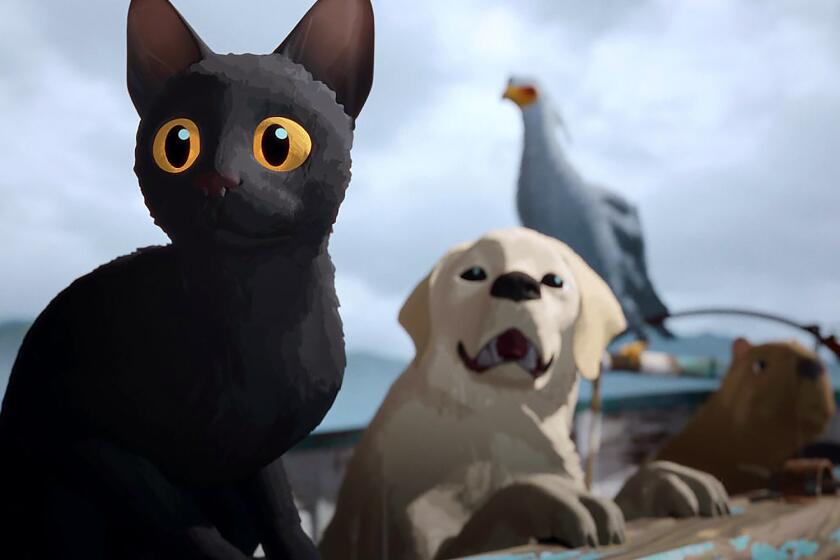Review: ‘Salt of the Earth’ captures photographer Sebastiao Salgado
When he looked over the edge of Brazil’s massive Serra Pelada mine, about to take one of the 20th century’s most iconic photographs, Sebastião Salgado said, “every hair on my body stood on edge. The pyramids, Babel, the history of mankind unfolded. I had traveled to the dawn of time.”
That panoramic shot of 50,000 men working without the aid of machinery in an enormous gold mining pit, each and every one of them “slaves to the cause of getting rich,” is just one of hundreds of justifiably admired photographs that have made Salgado one of the most recognizable names in contemporary photojournalism.
But whether you’re familiar with Salgado’s name and work or not, the documentary “The Salt of the Earth,” a popular prize-winner at Cannes and on the Oscar shortlist, will be a revelation.
Co-directed by the veteran Wim Wenders and Salgado’s son, Juliano Ribeiro Salgado, “The Salt of the Earth” deals with two kinds of journeys the photographer made. The outward one may have literally taken him to the furthest corners of the Earth and resulted in the stunning images the film features, but it is the inward journey that paralleled it that completely holds our attention.
That’s because Salgado, speaking in French and interviewed by an off-camera Wenders, turns out to be an articulate, thoughtful man whose tale of personal transformation changes the way we look at those photographs.
We also see, in segments of the film shot by his son, Salgado at work in various ultra-remote spots, visiting with the Yali people of Papua New Guinea, the Zo’e of Brazil’s Amazonia, even an island in the Arctic where the photographer literally rolls into position to snap some walruses at their leisure.
It is Salgado’s history, however, that pulls us in, starting with his youth on a large family ranch in remote Aimorés in Brazil. “Your way of seeing comes from where you are from,” the photographer says, and the truth of that becomes evident.
Salgado studied to be an economist, but the key event of his life was meeting his future wife, Leila (who became a driving force in Salgado’s career), when they were both young.
Brazil’s political unrest took them to France in 1969, where she bought a camera and Salgado took his first photograph — of her. A few years later they made the first of many joint decisions: They would invest in equipment and he would abandon his career track and attempt a career in photography.
Salgado’s first major project, “Otras Americas,” shot from 1977 to 1984 and taking him to several Latin American countries (though not Brazil), would establish the photographer’s pattern of complete respect for and immersion in the cultures he shot.
Wenders’ key idea for this film, to have Salgado look at his photographs and talk about them to the camera, works brilliantly because Salgado is a great storyteller and remembers key details about, for instance, the tribes he spent time with, like Mexico’s Tarahumara, who were celebrated long-distance runners, and Ecuador’s Saraguros, who thought he was an observer sent by God.
Gradually, however, Salgado’s photographs began to record tragedy and atrocities, and what he saw changed him. “We humans are a terrible animal; we are extremely violent,” he says. “Our history is a history of war; it’s an endless story. We should see these images to see how terrible our species is.”
Finally, after photographing genocidal killings in Rwanda and the Congo in the 1990s, Salgado had enough and began to deeply question his work as a social photographer.
“My soul was sick,” he remembers with remarkable vividness. “I no longer believed in anything, in any salvation for the human species.” He returned to the family property in Brazil, where something remarkable took place.
Disturbed by the deforestation he saw, Salgado and his wife formed the Instituto Terra and spearheaded an effort to replant an astonishing number of trees, well over 2 million and counting at this point, in an enduring attempt to restore the natural state of the area’s subtropical rainforest.
More than that, this project rekindled Salgado’s interest in photography, resulting in his latest major project, “Genesis,” for which he spent close to a decade taking pictures of the natural world. Those images, like all of Salgado’s work, are exceptional, but what makes “The Salt of the Earth” so special are the words that go along with them.
Twitter: @KennethTuran
-----------------------------------
‘The Salt of the Earth’
MPAA rating: PG-13 for thematic material involving disturbing images of violence and human suffering, and for nudity
Running time: 1 hour, 49 minutes
Playing: Laemmle’s Royal, West Los Angeles
More to Read
Only good movies
Get the Indie Focus newsletter, Mark Olsen's weekly guide to the world of cinema.
You may occasionally receive promotional content from the Los Angeles Times.











